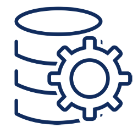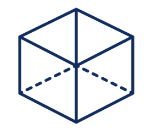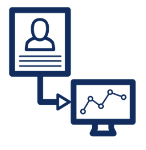Raise your hand if you’ve heard something like this… “Artificial intelligence is the key driver of the fourth industrial revolution and that data is the oil powering it.” Everyone’s hands raised? Good.
Most likely you read about, listened to, or worked with data in 2019 and if you thought you’d seen the last of it, think again. 2020 and the technology it will bring (think 5G, IoT, AI, etc.) will keep data on the forefront of bleeding-edge technology for years to come. Without any further innovation, data is already being used in unprecedented ways today.
With that in mind, we reached out to Bob Frady, CEO & Founder of HazardHub, which provides the most comprehensive property risk data ever created. As a self-proclaimed “Data Guy” we thought Bob would make a perfect next guest on our new “ForMotiv Forum” series where we dive a little deeper on companies making waves in the InsurTech space.
So, without further ado, let’s jump in…
First of all, congratulations on being named to the InsurTech 100 list! That’s quite an accomplishment. Prior to founding Hazard Hub, it seems like most of your career was spent in sales/marketing and, other than CoreLogic Spatial Solutions, the companies had seemingly nothing to do with what you’re doing now.
Just to level-set with our readers, mind giving a quick overview of our background and how HazardHub came to be?
So one thing that’s not on my LinkedIn profile (because I’m old) is that I ran the Insurance & Investments practice for National Decision Systems, a division of Equifax. So geospatial is really how I started my career.
But, yes, I was in marketing/sales for a long time and then I realized I didn’t actually know how to use any of these products I was selling.
I ended up going to work for CoreLogic because my now co-founder, John Sigman, who I used to work with at NDS, was running sales for CoreLogic Spatial and he said, “I need somebody to come in and take care of some major accounts so why don’t you come and help me.” So I ran a couple of major accounts for CoreLogic Spatial working with John. That’s where I met Brady our third co-founder, who is now HazardHub’s chief scientist. While I was there my former mother in law’s house flooded. She lives in western Massachusetts on the Berkshire River just outside of the flood zone. I said, “Did anybody ever tell you that you weren’t in a flood zone but you were right next to one? She said “No!” The insurance company didn’t tell her because they don’t cover floods and the bank didn’t tell her because she wasn’t in a flood zone. So she’s in this sort of in-between world with a lack of knowledge about the perils around her house. Of course, the river came up, did its thing, and she ended up losing a tremendous amount of money.
Then I thought that was an interesting business. What if you could flip the imbalance here and unlock the power of data to the insured rather than the carrier or bank. It became one of those “stuck in the back of my head” things as I ran back to the MarCom world. Long after we all left CoreLogic I got together with John and Brady and we said, “We’re seeing a ton of new data and great technology that no one is taking advantage of. Let’s do this.”
The MarCom world showed me that you can move around terabytes of data very easily, especially with cloud architecture. In the insurance world, it’s really kind of new to people that you can do this. So what we did is we took the proven geospatial concepts, improved those and then matched them with kick-ass technology. So, now we can deliver 700 data variables in two seconds for any address in the US. Maybe three if it’s a particular gnarly address.
How would you explain what HazardHub does to a high school class?
We tell you all the bad stuff that can happen to a property…plus a whole lot more.
Anytime someone says “terabytes” it begs the question, are you technical?
Yes and no.
I got into the engineering school at Cornell, although I’m not entirely sure how. I discovered I sort of lacked talent in the sciences but I learned enough to understand how systems work. In the process of my marketing jobs, I had to do a lot of technical development.
So I’m not a coder – but I’m very good at architecting systems because I understand a lot about marketing, I understand a lot about sales, I understand a lot about data, and I understand a lot about technology. When you pull all that stuff together I can architect systems that are pretty cool. The building of those systems is still something that I rely on other people for.
So I wouldn’t call myself technical in terms of being able to code but I would consider myself very technical in understanding the capability of technology.
What about your previous experience do you think contributed to the success HazardHub is seeing today?
Something that you see a lot in the InsurTech world is where people are so technical – they’re such brilliant technical builders – that they miss the forest for the trees. They can’t necessarily put together a product that makes any sense beyond what they see as being sensible. I always took the ability to see the big picture skill for granted. I thought that anybody could do it. What I’ve kind of figured out is that it’s not the easiest skill in the world to develop.
Because I’ve done so many different things and had a lot of different experiences I was able to be creative and, together with my co-founders, pull this all together.
It’s often said that data is the new oil/gold today – do you mind talking a little more about your overall data strategy?
There’s a ton of new data related to property risk that could be used to improve how organizations currently do things. But it can be tough to make sense of that data. As Brady, our Chief Scientist, says, “Every database is like a wild horse. You have to learn how to break it before you can ride.” And our skill is in breaking down data to a form that’s rideable if you will. And for our customers to make sense of it.
For instance, how do you underwrite more efficiently? How do you make sure that your pricing decisions are based upon consistent national predictable data? So there is that.
Also, people are buying houses with incomplete information. A friend of mine is selling his home. It’s in a 500-year flood zone. It’s like, “well that’s not disclosed anywhere in the real estate report.” These are the sorts of things we want people to know before they plunk down their life savings on a property.
But, in terms of our business, we were initially going to be a lead gen company. We were going to just give the property data to consumers in exchange for their information and then use that information to become a lead gen company. We still think there’s a business there. It’s just a very expensive business to build. When you’re bootstrapped you have to pick. So we have had a pivot. We don’t do lead generation. Now we just put that data out there for free for people to look at. No obligation. But we do focus on the B2B market in a way that others haven’t before. We take a B2C approach to a B2B problem. Which is how are you easy to work with. How do you make it simple to interact with our company?
Talk to me more about your AI/ML strategy. Do you subscribe to the “AI-as-a-buzzword” hype?
So last April Fool’s Day we changed the name of our company to HazardHub A.I. Everyone was like, “Congratulations!” Which we thought was pretty funny.
The A.I. for us stands for “actual information.” Nothing beats actual information. So our goal was always to gather more actual information. Now what we do is we use machine learning to help us get to that actual information that makes sense.
So ML is a tool for us. It’s not the output for us. The output we always want to have is A.I.
And that said we do build some models on top of our data which helps people to digest those data elements better. Like our wildfire model is crushing it right now in the marketplace but it is a model. But it’s not a linear regression type of the model. It’s more of a scoring algorithm type of a model. So those are important. We use those but really the core of everything is A.I. which is actual information.
If you were to sum it up in one sentence would it be something as simple as: “We help you make smarter underwriting decisions.”
Yes. Yes. One of the things that we’ve set out to do is drive the cost of data down. We really want to punch a hole in the bottom of the market. It’s a race to the bottom and we’re leading the charge because the data is too expensive and people don’t use it enough. So we think that by expanding the amount of data that you can get at a lower cost, and that data is better than what you currently have available, that opens the door to everyone making better decisions.
So yes it’s primarily focused on underwriting. The real benefit comes in pricing, though.
Listen, every property is insurable if you get the proper premium. And how do you use data to right-size your premium? Tougher to do in personal lines because of state regulations. Easier to do in commercial lines and the E&S world because you have some more premium flexibility. That’s where we see a lot of our business.
But in driving this price down we’re seeing it open up into other areas of the world beyond insurance.
But for now, yes, I think that’s where we are today.
Taken from your website: “Hazard databases require PhD level expertise to translate huge amounts of geospatial digital data into easy to understand answers that can be used to make real-world decisions.” Do you have a bunch of satellites orbiting the Earth to get data no one else has?
You know we’re very lucky in that the US government is a copious source of information so we start with that.
But there are hundreds of government and private entities that publish data.
So we have about 700 databases altogether that are in the pool. We start with government data which is national. We create our own fire station database. We’ve created our own fire hydrant database roughly 10 and a half million fire hydrants locations across the US. HydrantHub is the largest database of its kind but a lot of that is a combination of getting data from municipalities and building it ourselves. We’ve got the nation’s only underground storage tank database. I think our expertise is that we’re data wranglers, you know, we’re going out there finding these wild horses we’re breaking in to make them usable and accessible. That’s really our expertise. We’re data and technology guys. We happen to live in the insurance world and we have a lot of expertise around what data makes sense for insurance.
Do you have competitors? What sets HazardHub apart? Go ahead and brag.
The arrogant part of me wants to say no one! Because we’re doing things that no one else is doing. That said. In the realm of underwriting prefill data, there are a couple of billion-dollar competitors. We also see some smaller competitors that specialize in a particular line of business or particular risk. But in terms of the comprehensiveness of what we do, I think that those two giants are probably our biggest competitors.
The question becomes, “how do you compete with a billion-dollar company?” The answer is to be better, faster, and easier to work with. The existing products aren’t terrible. They’re just old and at the end of their product life cycle. We have the benefit of a new birthday. We use today’s technology because we have the ability to do that. We don’t have to retrofit a system. We don’t have an expensive infrastructure to support the way that they do. We don’t have to monetize prior acquisitions. So it gives us certain advantages.
I would be thrilled if everybody knew all of the dangers that were available around their property and that insurance companies shared that with their consumers whether it’s commercial or personal lines because that’s the whole goal here – to democratize this data. The big companies aren’t doing it so, we’ll do it.
It’s funny, I got this thing about competitive intelligence for 2020 and it’s like… I don’t care what my competition is doing. I really don’t. You know, to me, I have so much faith in what we’re doing. We will give people our data and say prove it to yourself. Because if you haven’t proven it to yourself we don’t want you as a customer – you’ll end up being a pain in the neck.
So if anybody ever has a question about our data we just give it to ’em, to test it out. Here’s a thousand records for free and if you want more than that then you can pay us a small fee. You know, it’s a “prove it to yourself – don’t just take my word for it” mentality.
We’ve always believed that our data is great. The cool thing is that we’ve got proof for it now. That proof came around because we had so much faith in what we did that we gave people the data. They proved it out and sent it back to us saying things like “Holy cow! This is great stuff!” It’s the excitement of those partners and carriers who have proved our data to themselves that’s the coolest part of what we do. Plus – for the doubting Thomas of the world – we can now flash up the gains chart that looks pretty spectacular.
Lastly, when we first spoke you said something I loved which was, “The good news is, we’re just getting started!” Which begs the question…What’s next for HazardHub?!
The first thing we want to do is to continually improve the data we have. For example, we’ve added 59,003 new fire hydrant locations in the last two weeks. We’ll also be launching updates to our HazardHub Wildfire Model and HazardHub Flood Model in Q1.
Secondly, we want new data. Two big efforts we have underway are 1 Meter elevation and sea-level rise data. Which should be fun.
Final Final: What would you tell aspiring InsurTechs?
I tell people that I started an InsurTech because I wanted to make money as slowly as possible.
The sales cycle is enormously long. It’s a very long walk in the desert with a very small bottle of water.
Now there are some situations where you can get around that but for the most part the closer you are to the core, which is actuary and underwriting, the longer your sales cycle. As many as three to four years. So don’t burn too much capital while you’re going through that sales process. You will burn yourself out if you do, and you’ll end up diluting yourself right out of your business because you now need more capital.







